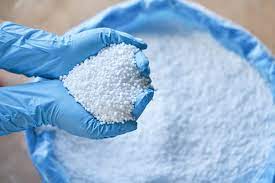UREA
Urea: Essential Fertilizer for Agriculture and Industrial Applications
Urea, also known as carbamide, is a nitrogen-rich compound used extensively as a fertilizer in agriculture and in various industrial applications. Its high nitrogen content, typically around 46%, makes it one of the most concentrated nitrogen fertilizers available on the market. Urea is highly soluble in water, which allows it to be easily absorbed by plants, promoting growth and enhancing crop yields. Additionally, it is used in industries such as chemicals, pharmaceuticals, and manufacturing.


What is Urea?
Urea is an organic compound that occurs naturally in the human body as a waste product from the breakdown of proteins. Industrially, urea is synthesized from ammonia and carbon dioxide in a process called the Haber-Bosch process. The result is a white, crystalline solid that is highly effective in providing the nitrogen that plants need for growth and development.
Urea is non-toxic and environmentally friendly when applied appropriately, making it the most widely used nitrogen fertilizer globally. Besides its agricultural uses, urea has several industrial applications, including in the production of plastics, resins, and as an additive in diesel exhaust systems to reduce emissions.
Grades and Forms of Urea
Urea comes in different grades and forms, each suited for specific applications:
Granular Urea: This is the most common form of urea used in agriculture. Granular urea has larger particles than prilled urea and is typically used for spreading on crops, ensuring a slow and controlled release of nitrogen.
Prilled Urea: Prilled urea has smaller particles and is used in both agriculture and industry. Its fine texture makes it easy to blend with other fertilizers or use in chemical manufacturing.
Technical Grade Urea: This type of urea is of a higher purity and is used in industrial applications such as chemical manufacturing, pharmaceuticals, and as an anti-caking agent.
Feed Grade Urea: This type of urea is specifically formulated for use in animal feed, providing a non-protein nitrogen source for livestock.
Key Features of Urea
High Nitrogen Content: Urea contains 46% nitrogen, making it the most concentrated nitrogen fertilizer available. This allows farmers to provide essential nutrients to their crops efficiently.
Cost-Effective: Due to its high nitrogen content and ease of production, urea is one of the most affordable nitrogen fertilizers on the market, making it accessible for farmers of all scales.
Versatile Use: Urea can be applied directly to soil or mixed with other fertilizers. It is suitable for a wide variety of crops, including grains, fruits, and vegetables, as well as for pastures and lawns.
Industrial Applications: Beyond agriculture, urea is widely used in industries. It is a critical component in the production of melamine and other resins, and it is used as a reducing agent in diesel engines (in the form of DEF – Diesel Exhaust Fluid) to lower NOx emissions.
Agricultural Applications of Urea
Urea plays a crucial role in global agriculture, supporting the world’s food supply by promoting healthy plant growth. Its application in farming has the following benefits:
Crop Fertilizer: Urea provides crops with a readily available source of nitrogen, which is vital for protein synthesis, chlorophyll formation, and overall plant growth. Farmers use urea to boost the productivity of staple crops such as wheat, corn, rice, and soybeans.
Improving Soil Fertility: Urea helps improve the nitrogen content in the soil, replenishing nutrients that are often depleted by continuous farming. It is often used in crop rotation systems to maintain soil health and fertility.
Blending with Other Fertilizers: Urea is often blended with other fertilizers to provide a balanced mix of nutrients for plants. It can be combined with potassium and phosphorus fertilizers to create complete nutrient solutions.
Controlled Release: When applied in granular form, urea provides a slow and steady release of nitrogen, ensuring that plants receive a consistent supply of nutrients over time. This reduces the need for frequent applications.
Industrial Applications of Urea
Beyond its use as a fertilizer, urea has several industrial applications, including:
Chemical Manufacturing: Urea is used as a raw material in the production of chemicals like urea-formaldehyde and melamine resins, which are essential in the manufacture of adhesives, laminates, and plastics.
Diesel Exhaust Fluid (DEF): Urea is a key ingredient in DEF, which is used in Selective Catalytic Reduction (SCR) systems in diesel engines to reduce nitrogen oxide (NOx) emissions. This application helps lower pollution from diesel vehicles and meets environmental regulations.
Pharmaceuticals: Urea is used in the production of various pharmaceuticals and medical products. It is commonly found in skin creams and lotions as a moisturizing agent, due to its ability to enhance skin hydration.
Explosives: Urea is also used as a component in some types of explosives, such as urea nitrate. This application is primarily for industrial use, such as in mining or construction.
Benefits of Urea
High Efficiency: Urea’s high nitrogen concentration allows farmers and industrial users to get more value from smaller quantities. It is particularly effective in nitrogen-deficient soils.
Easily Soluble: Urea dissolves quickly in water, making it easy to apply to crops through irrigation systems or as a foliar spray. Its water solubility also makes it suitable for use in industrial processes.
Cost-Effective Solution: Urea is inexpensive to produce, making it one of the most cost-effective nitrogen fertilizers and industrial chemicals available.
Environmental Benefits: In applications like DEF, urea plays a significant role in reducing harmful emissions from diesel engines, contributing to cleaner air and reduced environmental impact.
Challenges in Using Urea
Volatilization: When urea is applied to the surface of soil without proper incorporation, nitrogen can be lost as ammonia gas, reducing its effectiveness. To maximize its efficiency, it is recommended to apply urea when the soil is moist or to incorporate it into the soil.
Leaching: In areas with heavy rainfall or excessive irrigation, urea can leach into groundwater, potentially causing environmental issues. Proper application techniques and timing are essential to prevent nutrient loss.
Handling and Storage: Urea is hygroscopic, meaning it readily absorbs moisture from the air, which can cause it to clump and lose its effectiveness. It requires proper storage in dry conditions to maintain its quality.
Urea Supply Chain
The global supply chain for urea involves several stages:
Production: Urea is produced industrially from ammonia and carbon dioxide through the Haber-Bosch process. Large-scale production facilities are typically located near natural gas sources, as natural gas is a key input in ammonia production.
Transportation: Urea is transported in bulk via ships, rail, or trucks. For long-distance transportation, it is often shipped in granular or prilled form to ensure ease of handling and application.
Storage: Proper storage conditions are crucial for maintaining urea’s quality. It should be kept in a dry environment to prevent it from absorbing moisture and becoming less effective.
Distribution: Urea is distributed to farms, industrial plants, and other end users through a network of suppliers and distributors. It is available in various packaging sizes, from bulk shipments to smaller bags for individual farmers or industrial buyers.
Why Choose Urea?
Cost-Effective Nitrogen Source: Urea provides the highest nitrogen content available, making it the most efficient and cost-effective option for farmers and industrial users alike.
Versatile Applications: Whether you’re looking to improve crop yields, reduce diesel emissions, or produce industrial chemicals, urea offers a wide range of uses to meet your needs.
Global Availability: Urea is produced and available worldwide, ensuring a consistent and reliable supply for agricultural and industrial applications.
Environmental Impact: By choosing urea-based products like DEF, you contribute to reducing harmful emissions and promoting more sustainable industrial practices.
Contact Us for Urea Supply
As a leading supplier of high-quality urea, we are committed to meeting your agricultural and industrial needs. Our extensive network ensures timely delivery and expert support. Contact us today to learn more about how we can provide the urea products you require for your business or agricultural operations.

